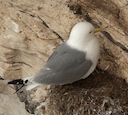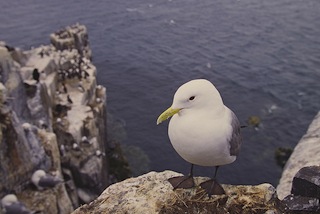 Kittiwakes live far out at sea during the winter, but can be spotted round the coast in the breeding season, from March to August.
Kittiwakes live far out at sea during the winter, but can be spotted round the coast in the breeding season, from March to August.
Photo: © Natural England/Neil Pike
Scientific name: Rissa tridactyla
Other common names: Black-legged Kittiwake, Tarrock (for juveniles)
Cornish name: Karawek berrdhu
Conservation status: UK Birds of Conservation Concern, Red
What to look for:
- Colouring and appearance: Gull-like appearance, white underparts and grey back and wings with black wingtips, a small yellow bill and short, black legs (very occasionally orange or red). When breeding, the dark eye develops a red rim. In winter, when the birds are at sea, they develop a dark grey patch behind the eye and on the back of the neck.
- Size: Wingspan 93 to 108 cm, length 37 to 42 cm.
- Where: Close to the coast from February to August; at sea in winter.
- Call: The shrill call ‘kittee-waake’ gave rise to its name
- Similar species: Common Gull, which has green-coloured legs; Herring Gull, which is larger than the Kittiwake.
 Kittiwakes must have nerves of steel. Breeding colonies can nest on sheer, vertical cliffs, making use of narrow ledges to build their moss- and seaweed-lined nests, in which they lay either one or two eggs. The same nest site is used for years in succession. The Black-legged Kittiwake and its sister Rissa species, the Red-legged Kittiwake (which is not found in the UK), are in fact the only two gull species to nest on cliffs. While the young of other gulls have a tendency to wander from the nest, Kittiwake chicks stay put, as they would otherwise risk falling. After fledging, the juveniles at first look somewhat different from mature adults, having black zig-zag markings on the wings, and dark markings on the neck, crown and behind the eyes.
Kittiwakes must have nerves of steel. Breeding colonies can nest on sheer, vertical cliffs, making use of narrow ledges to build their moss- and seaweed-lined nests, in which they lay either one or two eggs. The same nest site is used for years in succession. The Black-legged Kittiwake and its sister Rissa species, the Red-legged Kittiwake (which is not found in the UK), are in fact the only two gull species to nest on cliffs. While the young of other gulls have a tendency to wander from the nest, Kittiwake chicks stay put, as they would otherwise risk falling. After fledging, the juveniles at first look somewhat different from mature adults, having black zig-zag markings on the wings, and dark markings on the neck, crown and behind the eyes.
 Black-legged Kittiwakes differ from other gull species in other ways. For one thing, the hind toe on their feet is reduced or absent, so they in effect have only three working toes (the species name tridactyla is derived from the Greek for ‘three toes’). They do not feed at rubbish tips and landfill inland, or steal your ice cream cone from picnic benches at the seaside. They rarely venture far from the coast and sea, where they eat marine invertebrates and fish by skimming or diving to take prey from immediately below the surface of the water. They are not aggressive scavengers, unlike other gulls, and are generally gentler in nature, though they will sometimes scavenge for offal discarded from fishing boats. Their pelagic lifestyle on the open ocean outside of the breeding season also distinguishes them from most other gulls. Neither do they mob intruders to nesting sites: they don’t need to, because it is a rare intruder that can scale the steep cliffs on which they breed to get to the nests. Humans have therefore been one of their main predators in the past: see ‘Did you know…?’ below.
Black-legged Kittiwakes differ from other gull species in other ways. For one thing, the hind toe on their feet is reduced or absent, so they in effect have only three working toes (the species name tridactyla is derived from the Greek for ‘three toes’). They do not feed at rubbish tips and landfill inland, or steal your ice cream cone from picnic benches at the seaside. They rarely venture far from the coast and sea, where they eat marine invertebrates and fish by skimming or diving to take prey from immediately below the surface of the water. They are not aggressive scavengers, unlike other gulls, and are generally gentler in nature, though they will sometimes scavenge for offal discarded from fishing boats. Their pelagic lifestyle on the open ocean outside of the breeding season also distinguishes them from most other gulls. Neither do they mob intruders to nesting sites: they don’t need to, because it is a rare intruder that can scale the steep cliffs on which they breed to get to the nests. Humans have therefore been one of their main predators in the past: see ‘Did you know…?’ below.
Although one of the most abundant gull species globally, breeding numbers have been declining in the UK since the late 1980s, which is the reason for its Amber status.
Did you know…?
…In Victorian times, local people at Flamborough Head and Bempton Cliffs took advantage of the Kittiwake’s habit of not flying away from the nest by scaling the cliffs to ‘harvest’ the adults. They took their wing feathers to adorn hats and this became a thriving trade for a while. Watch this short film on BBC Nature to discover more.
…Kittiwake/human interactions are not always like those with the Victorian hatmakers. Normally a strictly coastal species, a colony of Kittiwakes has moved onto the Tyne Bridge in Newcastle, using it to nest during the breeding season. The cleaning up of the Tyne means that fish is plentiful, and the colony continues to thrive.
More information and references:
Svensson, L., Mullarney, K., Zetterstrom, D.,1986. Collins Bird Guide, second edition (translated by Christie, D., Svensson, L.). HarperCollins, London.
Published: September 2014
Author: Amanda Scott
Photos: Top, © Natural England/Paul Glendell); bottom, © Natural England/Neil Pike 2000
